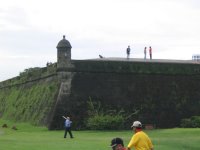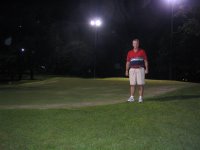
 Ray played in a tournament at Club Intramuros in downtown Manila. The tournament was the 3rd MIT Dean's cup. MIT is not the Massachusett Institute of Technology, nor is it the University of Minnesota Institute of Technology (my alma mater), but rather one of the top local engineering schools--Mapua Institute of Technology. The course rings around the ancient walled city of Intramuros just off Manila Bay. Intramuros was originally built during the Spanish colonization period in the late 1500's and served as the capital. Inside the walls are San Agustin Church, the Manila Cathedral, and Fort Santiago. In addition are many businesses and restaurants. The course sits on what used to be a protective moat around the walls that have been filled in. It was nearly destroyed by bombing in World War II by both the Japanese who took it over and the US who eventually liberated it. Some of it has been rebuilt, and some parts have been left bombed out.
Ray played in a tournament at Club Intramuros in downtown Manila. The tournament was the 3rd MIT Dean's cup. MIT is not the Massachusett Institute of Technology, nor is it the University of Minnesota Institute of Technology (my alma mater), but rather one of the top local engineering schools--Mapua Institute of Technology. The course rings around the ancient walled city of Intramuros just off Manila Bay. Intramuros was originally built during the Spanish colonization period in the late 1500's and served as the capital. Inside the walls are San Agustin Church, the Manila Cathedral, and Fort Santiago. In addition are many businesses and restaurants. The course sits on what used to be a protective moat around the walls that have been filled in. It was nearly destroyed by bombing in World War II by both the Japanese who took it over and the US who eventually liberated it. Some of it has been rebuilt, and some parts have been left bombed out.

To provide access to and from Intramuros, streets pass through the course between some of the holes. Guards provide crossing service for the golfers. They are dressed in special uniforms reminiscent of the Spanish Civil Guard. Many of the courses in the Philippines are recognized as Sanctuaries by the Audubon International Society, I think Intramuros should apply to the Autobahn Society for recognition of all the cars, trucks, vehicles and noise that are part of playing at Club Intramuros. After the first hole, you cross the busiest street by going over a bridge rather than testing your luck on the road.
 The walls of Intramuros and Fort Santiago come into play at times. Our group sent a few balls into and off the walls. In more cases than not, we got favorable returns. One person in our group hit off the top of the wall (which is slightly sloped toward the course and is about 25 feet wide) and ended up on the green. On the same hole, another bounced off the top and back to the center of the fairway.
The walls of Intramuros and Fort Santiago come into play at times. Our group sent a few balls into and off the walls. In more cases than not, we got favorable returns. One person in our group hit off the top of the wall (which is slightly sloped toward the course and is about 25 feet wide) and ended up on the green. On the same hole, another bounced off the top and back to the center of the fairway.
 The course is very tight and relatively short. It is only a par 66 with only one par 5. Most of the par 4's are between 300 and 350 yards long, is accuracy is more important than distance. Tee boxes and greens are very close to one another, except one hole that you walk about 120 up an adjacent fairway to get to the next tee box. In another place, the fairways actually intersect, but the intersection is very close to the tee box and protected by fencing, so after the drives you are out of each others way.
The course is very tight and relatively short. It is only a par 66 with only one par 5. Most of the par 4's are between 300 and 350 yards long, is accuracy is more important than distance. Tee boxes and greens are very close to one another, except one hole that you walk about 120 up an adjacent fairway to get to the next tee box. In another place, the fairways actually intersect, but the intersection is very close to the tee box and protected by fencing, so after the drives you are out of each others way.
 The course is literally an out and back layout. If you think of the course as a horseshoe, the first and 18th are at one end, and the 9th and 10th are near the other end. There is a break house after the 9th hole. The 10th hole is the signature hole here as it has an island green forcing you to be both accurate in length and direction.
The course is literally an out and back layout. If you think of the course as a horseshoe, the first and 18th are at one end, and the 9th and 10th are near the other end. There is a break house after the 9th hole. The 10th hole is the signature hole here as it has an island green forcing you to be both accurate in length and direction. Once the sun sets, you can continue your golfing here since the entire course is lit for night play. This has made it a tourist attraction. The clubhouse has undergone a recent upgrade and is clean and well lit. There was still some work going on in the clubhouse finalizing some of the tile work. We were done before the lights came on, but I went out to have a quick picture taken. There were numerous groups still on the course. The advantage of golfing at this time is the cooler temperatures.
Once the sun sets, you can continue your golfing here since the entire course is lit for night play. This has made it a tourist attraction. The clubhouse has undergone a recent upgrade and is clean and well lit. There was still some work going on in the clubhouse finalizing some of the tile work. We were done before the lights came on, but I went out to have a quick picture taken. There were numerous groups still on the course. The advantage of golfing at this time is the cooler temperatures.
No comments:
Post a Comment